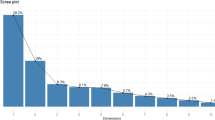Abstract
Sesame (Sesamum indicum L.) is an important edible oil crop. Meteorological factors such as temperature, rainfall, and the amount of solar radiation determine the yield potential of sesame. To identify phenotypic diversity and to infer genotypic backgrounds in a collection of 250 sesame germplasm accessions, we classified the germplasm based on variation in morphological traits using principal component (PC) and cluster analysis. The sesame germplasm was grouped based on five PCs, which accounted for 82.3% of total variation. The first PC (PC1) was positively correlated with days to flowering, days to maturity, and number of capsules per plant, whereas the second PC (PC2) was negatively correlated with all characteristics except capsule-bearing stem length. The third component (PC3) was highly positively correlated with capsule length and plant height. We constructed a scatter diagram of the first two PCs (PC1 vs. PC2), revealing four distinct groups of eigenvectors. Most sesame germplasm was widely distributed among Groups I, II, III, and IV. Group III showed a wide range of distribution in the diagram. Otherwise, the distribution of the 250 germplasm accessions was more compact in a scatter diagram of PC1 vs. PC3 compared with PC1 vs. PC2. Groups I, II, III, and IV contained 142, 102, 2, and 3 sesame germplasm accessions, respectively. The two germplasm in Group III were collected from different regions, as were the three germplasm in Group IV. The results show that the distribution of sesame origin is wider than the regions examined in view of phenotypic diversity.
Similar content being viewed by others
References
Ahn SN, Chae YA. 1984. Varietal Classification on the basis of multivariate analysis in sesame. Korean J. Breed. 16(3): 340–348
Endo S, Okada K, Nagao S, Appolonia BL. 1990. The characteristics of hard spring and winter wheats. •±. Statistical evaluation of reverse-phase high-performance liquid chromatography and milling data. Cereal Chem. 67: 486
Lee JI, Lee ST, Um GC, Park CH. 1982. Effect of planting date on agronomic characteristics and varietal differences in sesame varieties. Korean J. Crop Sci. 27(3): 268–275
Park CH, Lee JI. 1982. Response of flowering in sesame varieties. Educational-industrial cooperation. 180(29): 1–48
Richman M. 1986. Rotation of principal components. J. Climatol. 6, 293–335
SAS Institute. 2012. The SAS Enterprise Guide. SAS Institute, Inc., Cary, NC
Snedecor GW, Cochran WG. 1968. Statistical methods. 6th edition. Iowa State University Press, USA
Uzo JO. 1985. Yield, yield components and nutritional attributes of cultivated sesame, Sesamum indicum and its endemic wild relatives in Nigeria. FAO Pl. Prod. Prot. Paper: Sesame and Safflower: Status and potentials, pp. 166–176
Yingzhong Z, Yishou W. 2002. Genotype correlations and path coefficient analysis in sesame. Sesame and safflower newsletter No. 17: 10–12
Author information
Authors and Affiliations
Corresponding author
Rights and permissions
About this article
Cite this article
Shim, K.B., Shin, S.H., Shon, J.Y. et al. Classification of a collection of sesame germplasm using multivariate analysis. J. Crop Sci. Biotechnol. 19, 151–155 (2016). https://doi.org/10.1007/s12892-015-0099-4
Received:
Revised:
Accepted:
Published:
Issue Date:
DOI: https://doi.org/10.1007/s12892-015-0099-4




